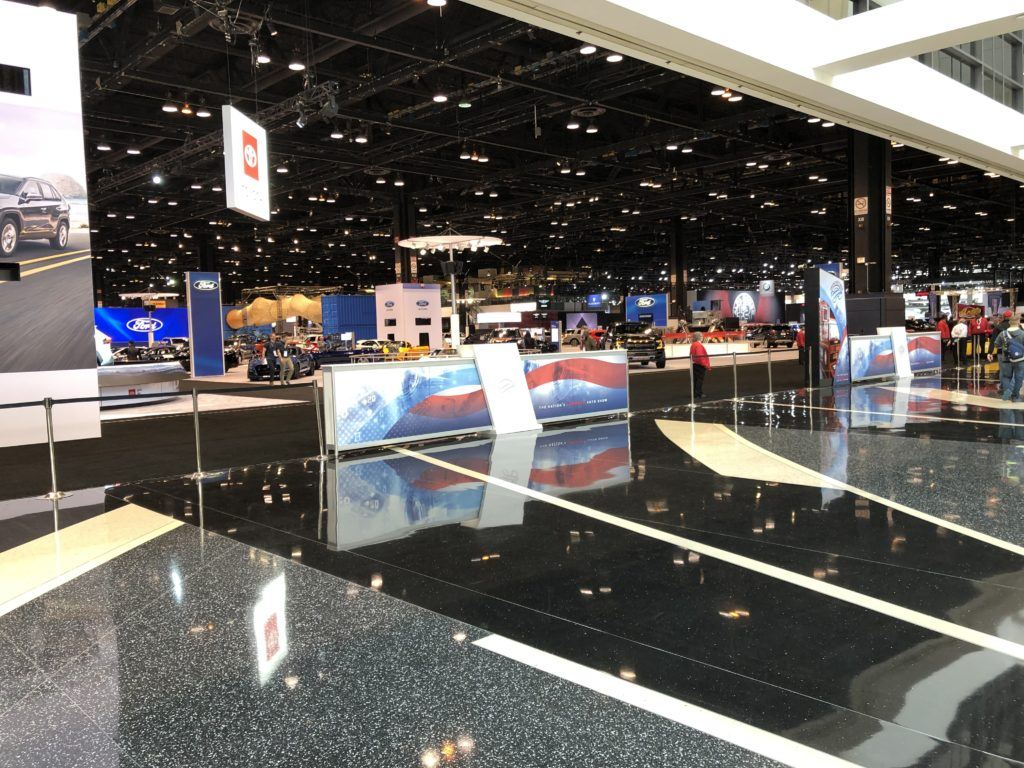
Every year, the Chicago Auto Show attracts enormous crowds anxious to see the latest models. Though the 2019 show opens on February 9th and runs through the 18th, we were able to attend to the media preview on the Friday before opening day as part of a group invited by MotorWeek, “television’s original automotive magazine” airing on PBS and Motor Trend TV, to be part of a show tour guided by John Davis, Motorweek’s erudite and entertaining host.
Attendance makes Chicago the largest auto show in the United States, as does size: the displays fill 1.2 million square feet in McCormick Place on the shore of Lake Michigan. The decision to push back the North American International Auto Show in Detroit to a June date starting in 2020 and convert it into a festival means Chicago will become the first major auto show of the year.
Automobile Chronicles focuses on automotive history, recognizing that today’s events are history in the making. From that perspective, the evolution of the show’s emphasis from automobiles to trucks was a reality check. Two years ago, Genesis debuted the brand and the G90, Lexus introduced the LS500 and LC500, and Cadillac introduced the CT6. Fiat Chrysler still displayed the Chrysler 200, though it had announced shortly before it would cease building the 200 and end production of small cars.
This year, the move away from automobiles to trucks and SUVs was everywhere obvious. The 2019 Chicago Auto Show introduced the new Chevrolet Silverado 2500HD, Ford’s Ranger, Jeep’s Gladiator, Kia’s Telluride, and the Cadillac XT6 and XT4. The newest automotive conveniences were for trucks – the GMC six way “MultiPro Tailgate” and tailgates from Ram that can open conventionally or as doors with a 60/40 split.
This year’s show illustrates how far from passenger automobiles the industry has traveled in only two years. In 2017, Fiat Chrysler’s decision to drop the 200 seemed almost blasphemous, so embedded was the notion that small cars were inevitably the future of the industry. Today, that decision is viewed as brilliant, with other manufacturers copying the Fiat Chrysler’s late Chairman Sergio Marchionne’s decision to focus plant and investment on SUVs and pickup trucks.
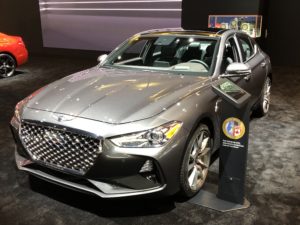
Genesis was one of the few exhibitors with a new automobile, the G70. Sharing its basic platform with Kia’s Stinger, the G70 has been uniformly praised by automotive journalists for both handling and luxury and offers a manual transmission option. (MotorWeek named the G70 its Luxury Sedan of the Year.) The model extends Genesis into a lower price range than the brand’s other models. But Genesis lacks any crossover or SUV – an omission that handicaps Genesis as it works to develop the network of stand-alone dealers essential to credibility as a true luxury brand.

Kia, on the other hand, has a brand new three-row crossover SUV: the Telluride. It is the featured vehicle for Kia at Chicago and is receiving all the promotional support Kia can offer – including airing an advertisement during the Super Bowl. Kia is are also making sure everyone knows the Telluride is built In the United States (in Georgia). Conventionally attractive – Kia proclaims their goal was to make it “big, bold, and boxy” and admits the design intentionally mimics the appearance of truck-based body on frame SUVs – the unit body Telluride is presented as offering luxury befitting its status as “flagship” of the Kia SUV line combined with serious off-road capability.
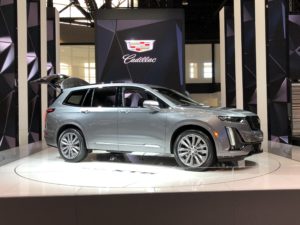
Cadillac, too, was emphasizing new crossovers. The new XT6 was given the premier spot on the highest turntable, while the recently-introduced XT4 sat on a lesser, lower turntable. The XT6 has a Cadillac grille and offers interior appointments familiar from the XT5, but offers a third row, plugging a hole in the Cadillac crossover SUV line. The XT6 is based on same platform as the GMC Acadia, but the rumor is that a replacement is already under development on a new platform more in keeping with Cadillac’s image as the luxury leader.
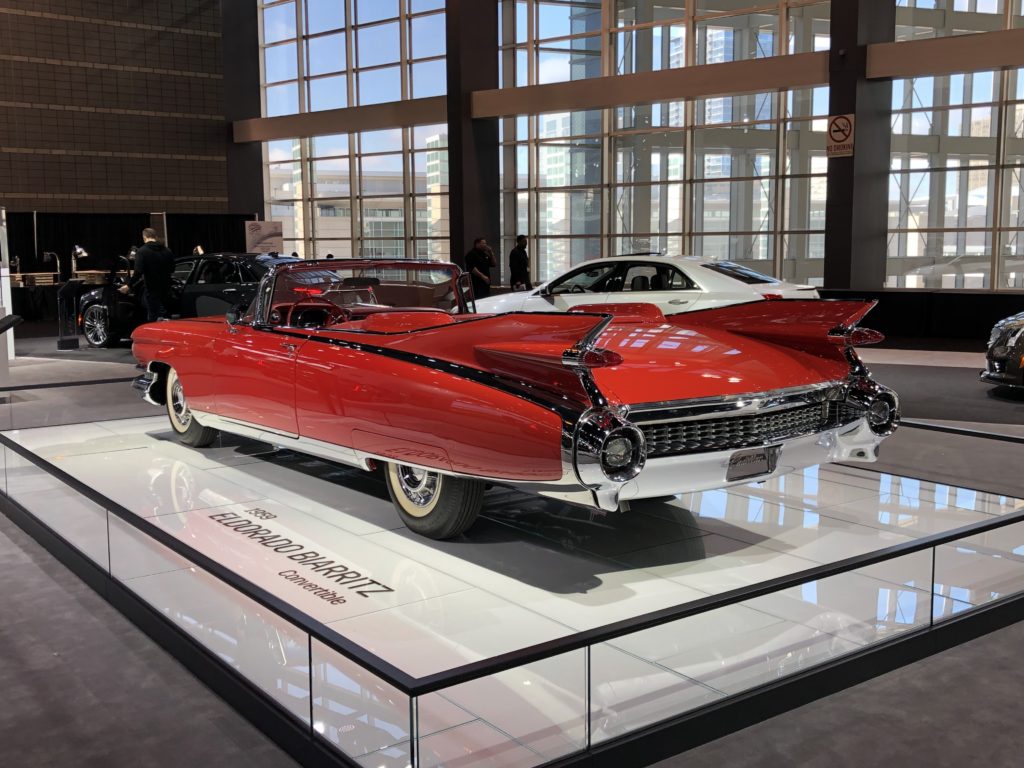
The real star of the Cadillac display was not an SUV, but a car – a convertible. In the middle of the Cadillac display was a bright red 1959 Cadillac Eldorado Biarritz convertible. Pristine and glorious, it was a reminder of the flamboyance and quality that once made Cadillac the prestige brand of the United States, not just of General Motors.
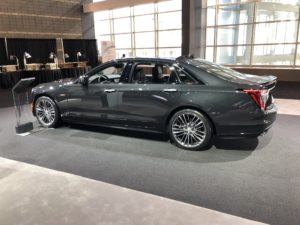
The new Cadillac on display that could excite automotive lust was nearby: a CT6-V with Manhattan Noir Metallic exterior and Dark Auburn interior with Jet Black accents. A cutaway of the 550 hp Blackwing V-8 that powers the CT6 V stood nearby. With the announcement that Cadillac is not discontinuing the CT6, the V version is likely to be available to more than the 275 buyers allowed to preorder, with supply meeting demand in later model years. That said, that the CT6 V, the pinnacle of Cadillac sedans, was relegated to a side space on the floor while the crossover SUVs were displayed on turntables above the other models showed that Cadillac, like the rest of the industry, is now all-in on cross-overs. (For more about GM’s decision to keep the CT-6 in production, at the top of the Cadillac line, see our post “GM Backs Down.””
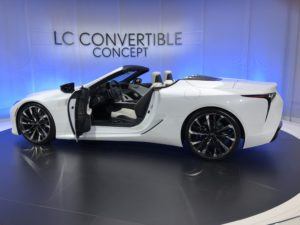
One luxury brand did give center stage to an automobile: Lexus showed the concept convertible version of the LC500. It is as certain to see production as the concept LC500 coupe was when we last visited the show two years ago and is even more beautiful than the coupe. (The LC is the only Lexus model on which the spindle grill is attractively integrated into the design of the vehicle.) There is no official word on when the convertible will appear in a dealer’s showroom.
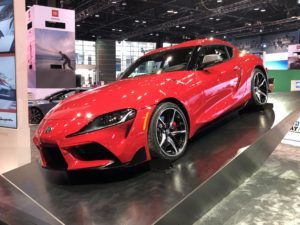
Toyota was the only brand in Chicago to present an entirely new production automobile: the Supra. Even so, it seemed almost an afterthought in Toyota’s Chicago display. Only one Supra was displayed, inaccessible on a tilted stand. Built in cooperation with BMW and sharing a platform with the BMW Z4, the Supra has a many design cues reminiscent of the last Supra, from the 1990‘s. The exterior is ovals and curves. It already looks dated.
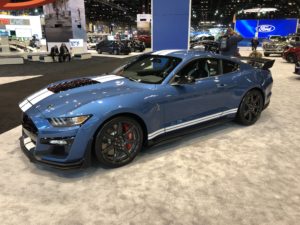
Ford displayed its latest Mustang: The Shelby GT500 aimed at both the Dodge Challenger Hellcat and the Chevrolet Camaro ZL1 1LE. Ford has not quoted specifics, but says the GT500 produces more than 700 hp. The more interesting Mustang was the Bullitt model the automotive press has uniformly praised as a perfect balance of power and handling.
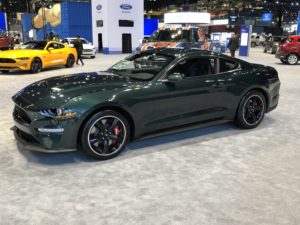
Seeing the new Bullitt Mustang, with its signature dark green paint and blackout grill, I felt a certain ambivalence. To someone who remembers seeing the movie in a first-run theatre (when the Mustang and Charger were new cars and everyone was talking about the chase scene), it seems almost cloying for an automobile so overtly to invite its purchaser to pretend being someone else. That said, at least it pays homage to one who bought his car for performance. Frank Bullitt was not an SUV man.
The model Ford really promoted in Chicago was the Ranger, its new-to-the-United States and smaller-than-an-F-150 pickup. Ford has been selling this vehicle in other markets for many years, after discontinuing the original Ranger small pickup in 2011. Back then, the cost difference between a Ranger and an F-150 made the Ranger a tough sell. The market for the Ranger has returned, though, as the cost of the F-150 has escalated with every model year and thereby opened a market for a less expensive truck. Toyota filled that gap with the Tacoma. Ford will try to claw back some of that market by producing the Ranger for the home market. (Trivia Question: what Ford Motor Company product first used the “Ranger” name? Answer, the 1958 Edsel Ranger.)
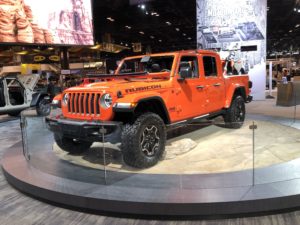
Another entry into the smaller pickup field is the Jeep Gladiator, though with a distinctly Jeep emphasis on off-road capability. The Gladiator – another ‘everything old is new again’ renewed nameplate (it was used from 1962 through 1988 for a conventional pickup based on the original Wagoneer) – claims to have best-in-class towing and payload capacities. It can be configured as an open vehicle by removing the doors and roof.
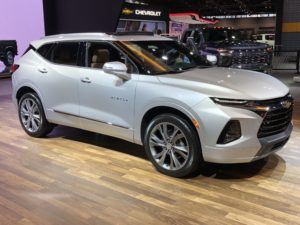
Chevrolet displayed Corvettes and Camaros, but their show stars were the new Blazer and 2020 Silverado 2500HD. Previous Blazers (later the Trailblazer) were SUVs derived from trucks – full-size at first and then based on the S-10 small truck line. Chevrolet dropped those vehicles in 2009 when it introduced the Traverse. The new Blazer is a unit-body crossover with no pretention to be a truck.
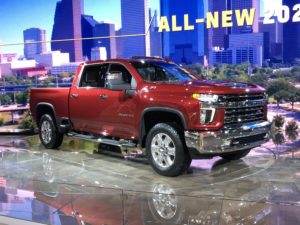
The Silverado 2500 HD is the vehicle General Motors is counting on to keep the company’s profits lush. As the Chicago show opened, GM announced a fourth quarter 2018 operating profit of $3.4 billion – almost entirely from the sale of trucks in the United States. General Motors, under CEO Mary Barra, has abandoned its previous focus on sales volume in favor of focusing on profit per vehicle. General Motors’ profits from selling pickups in the United States more than offset the decline of profits in China (which dropped in that period to only $300 million). Selling trucks in the United States is what makes money for General Motors today and their Chevrolet display at Chicago reflects that reality.
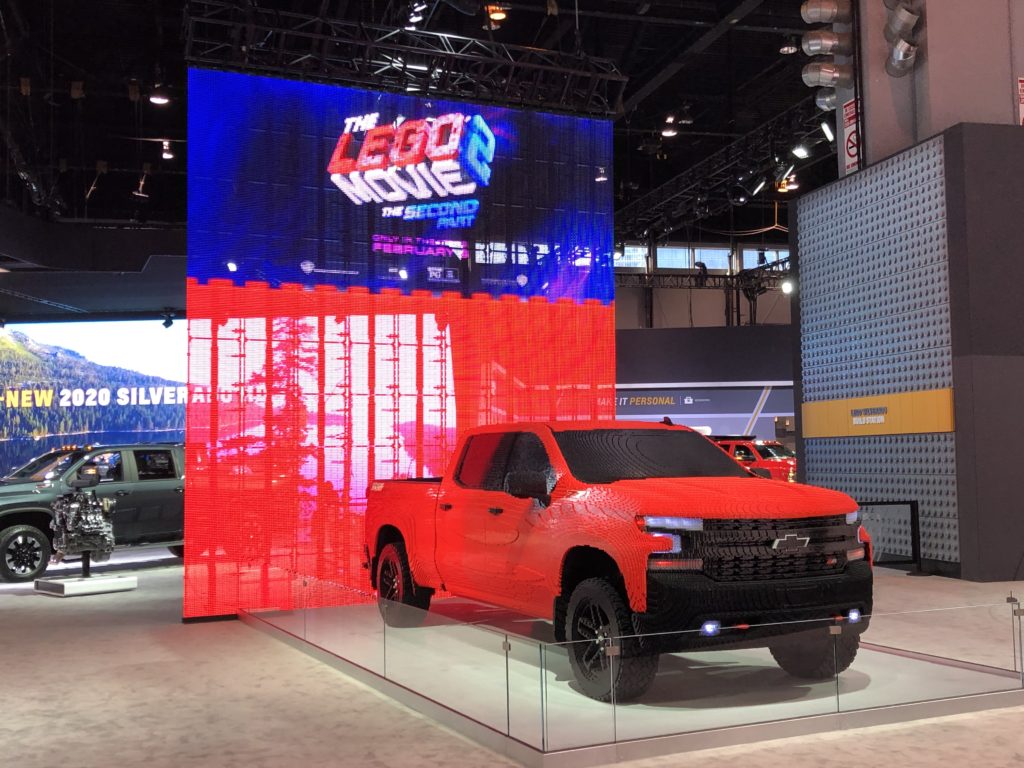
There was also a bit of whimsy at the Chevrolet exhibit. They not only showed the new Silverado 2500 HD in shiny splendor, but in Lego®. According to the statistics, the 2500 HD on display constructed of Legos® was built from 334,544 individual bricks, requiring the efforts of 20 “trained Lego® builders” and over 2,000 hours, primarily using red 2 X 8 stud bricks.
Towing and load capacities were not provided.


